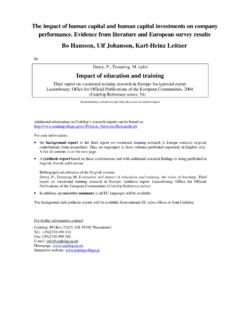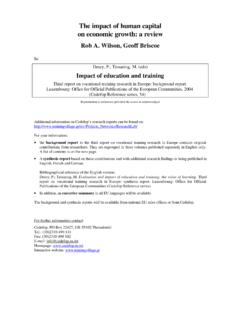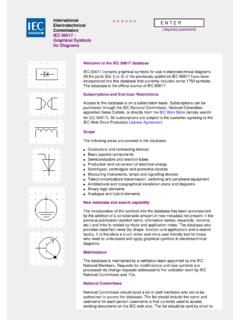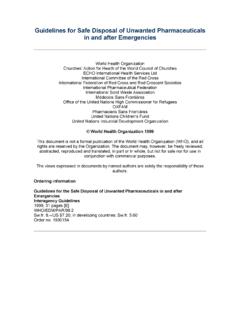Transcription of CARRYING OUT TRACER STUDIES - Cedefop
1 GUIDE TO ANTICIPATING AND MATCHING SKILLS AND JOBS VOLUME 6 CARRYING OUT TRACER STUDIESMore information on the European Union is available on the internet ( ). luxembourg : Publications Office of the European Union, 2016 Print: ISBN 978-92-9157-659-3 TA-06-16-005-EN-CPDF: ISBN 978-92-9157-660-9 TA-06-16-005-EN-N European Training Foundation / European Centre for the Development of Vocational Training / International Labour Office, 2016 Reproduction is authorised provided the source is contents of this publication are the sole responsibility of the author and do not necessarily reflect the views of the EU institutions or the International Labour design: Article 10 Printed in ItalyEurope Direct is a service to help you find answers to your questions about the European number (*).
2 00 800 6 7 8 9 10 11(*) The information given is free, as are most calls (though some operators, phone boxes or hotels may charge you).Harald SchomburgCompendium on Anticipation and Matching of SkillsGUIDE TO ANTICIPATING AND MATCHING SKILLS AND JOBS VOLUME 6 CARRYING OUT TRACER STUDIES5 CARRYING out tracerfistudiesFOREWORDIn a context of dynamic and complex labour markets, gathering intelligence on current and future skill needs can support better matching of training and jobs, which is of paramount importance for every country in the world. In recent years, better understanding of labour market needs and skills matching have featured high on the policy agenda of many countries, driven by both rapid technological advances and global competition.
3 Skills matching can also help reduce unemployment, particularly among young people. It helps build a better life for individuals by improving employability, social mobility and European Union (EU) places great emphasis on skills anticipation and better matching. The Europe 2020 strategy and, in particular, the Agenda for new skills and jobs, recognise that anticipation and matching approaches and methods can help develop a skilled workforce with the right mix of skills in response to labour market needs, in a way that promotes job quality and lifelong learning. The EU Skills Panorama, launched in 2012, supports the effort to provide better data and intelligence on skill needs in the labour tripartite representation of International Labour Organization (ILO) Member States agreed that countries that have succeeded in linking skills to gains in productivity, employment and development have targeted skills development policy towards three main objectives: matching supply to current demand for skills; helping workers and enterprises adjust to change; building and sustaining competencies (1) for future labour market a strategy includes anticipating and delivering the skills that will be needed in the future.
4 The ILO/G20 training strategy A skilled workforce for strong, sustainable and balanced growth (ILO, 2010) recognises anticipation of skill needs as one of the principal building blocks of effective skills development matching is a complex and dynamic process involving multiple stakeholders making multiple decisions at different times: individuals and their families, as they make decisions regarding their own education and training; education, training and labour market policy makers, as they decide on the configuration of education and training systems, employment policies and investments; training institutions, as they make decisions on the type and content of the training courses to be delivered; and employers, as they take decisions on how to train workers and utilise are changing rapidly and individuals are also changing their skill sets, either through education and training or through their work and life experience.
5 Education and training systems, in particular, have a key role to play in ensuring that opportunities are provided for all individuals to develop their skills continually in a lifelong learning perspective, enabling them to adapt to rapidly changing labour market requirements and the complexity and dynamics of the process, perfect matching between skills demand and supply is neither feasible (especially in rapidly changing labour 1 The terms competency(ies) and competence(s), although slightly different in meaning, are used interchangeably throughout this to anticipating and matching skills and jobsmarkets and economies) nor necessary, given the fact that many people can do many different jobs and many jobs can be done by people with different skill sets.
6 However, it is important for policy makers to be aware of the importance of reducing the risk of creating large skills gaps that undermine the employability of individuals and impede the productivity of enterprises and the growth of experience suggests that a comprehensive labour market information system (LMIS) is the backbone of any education and employment strategy, but no single methodology can generate sufficient knowledge of labour markets to avoid or minimise skills mismatch. The right mix and complementarity of different methods is essential for a reliable and comprehensive overview of skills demand and developing and transition countries, skills matching and anticipation is becoming an even more complex task given their particular socio-economic conditions, weak institutions, capacities and governance systems.
7 Many developing countries have limited labour market information and more effort and investment is needed to build robust information systems. At the same time, even limited evidence can be better, and more efficiently used, with proper methodological tools and respond to these challenges, the European Training Foundation (ETF), the European Centre for the Development of Vocational Training ( Cedefop ) and the International Labour Office have joined forces and combined expertise and geographic coverage to develop a compendium of methodological guides on anticipation and matching of skills supply and demand: Volume 1: how to use labour market information Volume 2: how to develop skills foresights, scenarios and forecasts Volume 3: what works at sector level Volume 4: what is the role of employment service providers Volume 5.
8 How to develop and run an establishment skills survey Volume 6: how to carry out TRACER six guides complement each other. They include both qualitative and quantitative approaches, and advocate strong social dialogue and institutions conducive to better understanding the skill needs of tomorrow. They target professionals, policy makers, researchers, social partners and experts who need an overview of how different anticipation and matching methodologies can generate reliable labour market information and how information and evidence can be analysed and used for the development of policy interventions or adjustments in education and employment compendium brings together state-of-the-art international good practice and experience worldwide.
9 The most common approaches used for skills matching and anticipation in different economic and country contexts are reviewed, and their potential and methodological shortcomings for generating reliable data and information are examined. They serve as reference material for readers to explain the scope, added value and limitations of diverse methodologies. The guides also provide insight into how the results of different methodologies can be analysed to provide recommendations and policy feedback from readers and users of the guides is very welcome , particularly regarding how the next editions could be improved or made relevant to their circumstances and policy dilemmas, how they are used in different countries and contexts, including especially in bringing stakeholders together, and which topics could be added in the future to complement the current Evans-Klock Chief of the Skills and Employability Branch Employment Policy Department ILO International Labour Office.
10 GenevaMadlen Serban Director ETF European Training FoundationJoachim James Calleja Director Cedefop European Centre for the Development of Vocational Training7 CARRYING out tracerfistudiesACKNOWLEDGEMENTSThis guide on TRACER STUDIES was commissioned by the ETF to help stakeholders in education and training institutions to analyse the paths and outcomes of learners after completion of study programmes of all Schomburg is the main author and the work reflects both his acknowledged expertise and also his belief in innovative approaches to TRACER STUDIES ; these are based on high standards of research and on bottom-up partnerships of education and training institutions committed to conception and drafting of the guide benefited from the motivating context of the team of ETF colleagues who, from the start, supported the author with relevant examples and practical suggestions for contextualisation of the guide to scarcity of resources and capacities, and to limitations in information systems in many countries.












